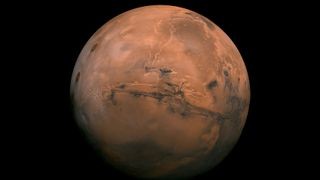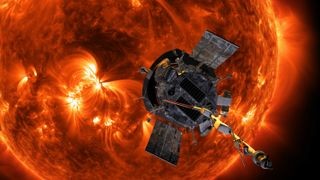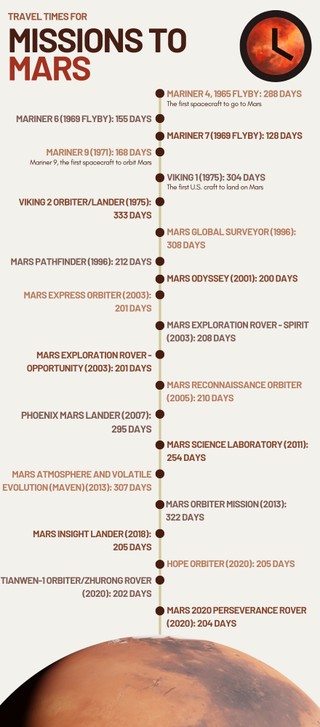How Long Will It Take To Travel To Mars? The journey to Mars is a topic of intense interest and speculation, especially for those dreaming of future space tourism. TRAVELS.EDU.VN explores the factors influencing this interplanetary voyage, offering insights into current technologies and future possibilities for space exploration. Understanding the Mars mission duration is key to planning future space travel endeavors, and appreciating the cosmic distance and challenges involved in space travel.
1. Understanding the Distance to Mars
Calculating the Mars travel time starts with understanding the astronomical distances involved. The distance between Earth and Mars is not constant. These two planets orbit the Sun at different speeds and distances, causing the separation between them to vary greatly.
- Closest Approach: The closest these two planets can get is approximately 33.9 million miles (54.6 million kilometers). This alignment is rare.
- Farthest Distance: At their farthest, when Earth and Mars are on opposite sides of the Sun, they can be as far apart as 250 million miles (401 million kilometers).
- Average Distance: On average, the distance between Earth and Mars is about 140 million miles (225 million kilometers).
 Mars from space, showing red surface details
Mars from space, showing red surface details
This fluctuating distance is a critical factor in determining the Mars trip time. The timing of a mission, known as a launch window, must be carefully chosen to minimize travel time and fuel consumption.
2. Travel Time to Mars at the Speed of Light
While human space travel is not nearly as fast as light speed, it’s a useful exercise to understand the theoretical minimum travel time. Light travels at approximately 186,282 miles per second (299,792 kilometers per second). Given this, the time it would take for light to travel between Earth and Mars is:
- Closest Possible Approach: 182 seconds (3.03 minutes)
- Closest Recorded Approach (2003): 187 seconds (3.11 minutes)
- Farthest Approach: 1,342 seconds (22.4 minutes)
- Average Distance: 751 seconds (12.5 minutes)
This comparison highlights the immense difference between the speed of light and the speeds achievable with current spacecraft technology, emphasizing the challenges of interplanetary travel.
3. The Fastest Spacecraft: Parker Solar Probe
Currently, the fastest spacecraft ever built is NASA’s Parker Solar Probe. This probe, designed to study the Sun, achieved a top speed of approximately 430,000 miles per hour (692,000 kilometers per hour) on December 24, 2024.
 Illustration of Parker Solar Probe approaching the sun
Illustration of Parker Solar Probe approaching the sun
If we hypothetically rerouted the Parker Solar Probe on its 22nd solar flyby and sent it on a direct path to Mars, the travel times would be:
- Closest Possible Approach: 78.84 hours (3.3 days)
- Closest Recorded Approach: 80.93 hours (3.4 days)
- Farthest Approach: 581.4 hours (24.2 days)
- Average Distance: 325.58 hours (13.6 days)
However, this is a purely theoretical exercise. The Parker Solar Probe is not designed for interplanetary travel and cannot carry humans or equipment necessary for a Mars mission. It’s crucial to note that this calculation assumes a direct route, which isn’t feasible due to orbital mechanics.
4. Factors Influencing Actual Travel Time to Mars
Several factors influence the actual travel time to Mars for a manned or unmanned mission:
- Orbital Mechanics: Spacecraft don’t travel in straight lines. They follow trajectories dictated by gravity and the relative positions of Earth and Mars. These trajectories are typically Hohmann transfer orbits, which are energy-efficient but take longer.
- Propulsion Systems: The type of propulsion system used significantly impacts travel time. Traditional chemical rockets provide high thrust but are fuel-intensive. Advanced propulsion systems, such as ion propulsion, offer higher efficiency but lower thrust, resulting in longer travel times.
- Mission Objectives: Whether the mission aims to orbit Mars, land on the surface, or simply fly by affects the trajectory and the amount of fuel required. Orbit insertion and landing require significant deceleration, adding to the complexity and duration of the mission.
- Launch Windows: As mentioned earlier, the alignment of Earth and Mars dictates when a launch is most feasible. These launch windows occur approximately every 26 months.
- Payload Mass: The mass of the spacecraft, including crew, equipment, and supplies, influences the amount of fuel required and, consequently, the travel time.
5. Expert Insights on Mars Mission Duration
Michael Khan, Senior Mission Analyst at the European Space Agency (ESA), provides valuable insights into the complexities of Mars travel.
Khan explains that the travel time to Mars is heavily dependent on the amount of energy expended, which includes the launch vehicle’s effort and the spacecraft’s maneuvers. He notes that transfers to Mars are interplanetary and are influenced by the eccentricity of Mars’ orbit and its inclination relative to Earth.
“Pork chop plots” are used to determine the optimal departure and arrival dates and the energy required for the journey. These plots show that opportunities for Mars transfers occur approximately every 25-26 months, with travel times varying from 5-8 months to 7-11 months. A common rule of thumb is that a Mars transfer takes about nine months, similar to human gestation, but this is only an approximation.
Khan also highlights that missions intending to orbit or land on Mars have longer journey times due to the need for orbit insertion and atmospheric entry, which require additional propellant and heat shields, limiting the range of possible trajectories.
6. Problems in Calculating Mars Travel Time
Calculating travel times to Mars is not as simple as dividing the distance by the speed of the spacecraft. Several factors complicate the calculation:
- Non-Linear Trajectories: Spacecraft do not travel in straight lines between planets. They follow curved trajectories influenced by the gravitational forces of the Sun and other planets.
- Changing Distances: The distance between Earth and Mars is constantly changing as the planets orbit the Sun. The spacecraft must be launched at the right time to intercept Mars at its future location.
- Orbit Insertion: Spacecraft need to slow down upon arrival at Mars to enter orbit or land on the surface. This requires additional fuel and careful timing.
 Historical timeline of Mars missions and travel times
Historical timeline of Mars missions and travel times
7. Historical Mars Missions and Travel Times
Examining the travel times of previous Mars missions provides a realistic perspective on what is currently achievable:
| Mission | Launch Date | Arrival Date | Travel Time |
|---|---|---|---|
| Mariner 4 | Nov 28, 1964 | Jul 15, 1965 | 7.5 months |
| Viking 1 | Aug 20, 1975 | Jun 19, 1976 | 10 months |
| Viking 2 | Sep 9, 1975 | Aug 7, 1976 | 11 months |
| Mars Pathfinder | Dec 4, 1996 | Jul 4, 1997 | 7 months |
| Mars Global Surveyor | Nov 7, 1996 | Sep 12, 1997 | 10 months |
| Mars Odyssey | Apr 7, 2001 | Oct 24, 2001 | 6.5 months |
| Mars Exploration Rover | Jun 10, 2003 | Jan 4, 2004 | 6.5 months |
| Mars Reconnaissance Orbiter | Aug 12, 2005 | Mar 10, 2006 | 7 months |
| Curiosity Rover | Nov 26, 2011 | Aug 6, 2012 | 8.5 months |
| Mars Atmosphere and Volatile Evolution (MAVEN) | Nov 18, 2013 | Sep 22, 2014 | 10 months |
| InSight Lander | May 5, 2018 | Nov 26, 2018 | 6.5 months |
| Perseverance Rover and Ingenuity Helicopter | Jul 30, 2020 | Feb 18, 2021 | 6.5 months |
These missions demonstrate that current technology allows for travel times ranging from approximately 6.5 to 11 months.
8. Future Technologies for Faster Mars Travel
Advancements in propulsion technology could significantly reduce the travel time to Mars. Some promising technologies include:
- Nuclear Thermal Propulsion (NTP): NTP uses a nuclear reactor to heat propellant, providing higher thrust and efficiency compared to chemical rockets.
- Nuclear Electric Propulsion (NEP): NEP uses a nuclear reactor to generate electricity, which powers ion thrusters. NEP offers very high efficiency but low thrust, making it suitable for long-duration missions.
- Fusion Propulsion: Fusion propulsion uses nuclear fusion reactions to generate thrust. Fusion propulsion has the potential to provide very high thrust and efficiency, but it is still in the early stages of development.
- Directed Energy Propulsion: Directed energy propulsion uses a powerful laser or microwave beam to push a spacecraft. This technology could potentially enable very fast travel times to Mars.
Philip Lubin, a physics professor at the University of California, Santa Barbara, is working on Directed Energy Propulsion for Interstellar Exploration (DEEP-IN). He suggests that this method could propel a 220-lb. (100 kilograms) robotic spacecraft to Mars in as little as three days.
9. Human Considerations for Mars Travel
Human missions to Mars present unique challenges related to the extended travel time:
- Radiation Exposure: Astronauts would be exposed to high levels of cosmic radiation during the journey, increasing the risk of cancer and other health problems.
- Psychological Effects: The isolation and confinement of a long-duration space mission can have significant psychological effects on the crew.
- Physiological Effects: Prolonged exposure to microgravity can cause bone loss, muscle atrophy, and cardiovascular problems.
- Life Support: Maintaining a closed-loop life support system for a multi-year mission is a significant engineering challenge.
These challenges require innovative solutions in spacecraft design, life support systems, and medical care.
10. Planning Your Future Trip to Mars with TRAVELS.EDU.VN
While a trip to Mars may still be years away, TRAVELS.EDU.VN is here to help you plan for the future of space tourism. Understanding the complexities of interplanetary travel is the first step towards realizing this incredible dream. We provide information, resources, and expert insights to keep you informed about the latest developments in space exploration.
Imagine yourself embarking on a journey to the Red Planet. As you consider this journey, remember that planning is key, and TRAVELS.EDU.VN can assist you. Contact us to explore potential future travel packages to Mars. Our team is prepared to guide you through the possibilities and assist with any inquiries.
Contact Information:
- Address: 123 Main St, Napa, CA 94559, United States
- WhatsApp: +1 (707) 257-5400
- Website: TRAVELS.EDU.VN
Let TRAVELS.EDU.VN be your companion in exploring the universe, from the vineyards of Napa Valley to the distant landscapes of Mars.
FAQ: Frequently Asked Questions About Mars Travel
-
How long does it take to get to Mars with current technology?
With current technology, a one-way trip to Mars typically takes between 6.5 to 11 months.
-
What is the fastest possible travel time to Mars?
Theoretically, using directed energy propulsion, a robotic spacecraft could reach Mars in as little as three days, but this technology is still under development.
-
Why does the distance between Earth and Mars vary?
The distance varies because Earth and Mars orbit the Sun at different speeds and distances.
-
What are launch windows for Mars missions?
Launch windows occur approximately every 26 months when Earth and Mars are in favorable positions for efficient travel.
-
What is a Hohmann transfer orbit?
A Hohmann transfer orbit is an energy-efficient trajectory used to travel between two planets, but it takes longer than a direct route.
-
What are the main challenges of human missions to Mars?
The main challenges include radiation exposure, psychological effects, physiological effects, and life support.
-
How do mission objectives affect travel time to Mars?
Missions that require orbit insertion or landing take longer due to the need for deceleration.
-
What is nuclear thermal propulsion?
Nuclear thermal propulsion (NTP) uses a nuclear reactor to heat propellant, providing higher thrust and efficiency compared to chemical rockets.
-
How does the mass of a spacecraft affect travel time to Mars?
A heavier spacecraft requires more fuel, which can increase travel time.
-
What role does TRAVELS.EDU.VN play in future space tourism?
travels.edu.vn provides information, resources, and expert insights to keep you informed about the latest developments in space exploration, helping you plan for future space travel endeavors.